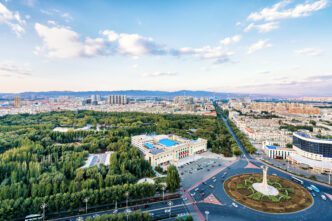Ireland’s data centers, pivotal for the AI industry, now consume more electricity than all urban homes combined. As the demand grows, the country’s energy resources and climate goals face significant strain.
Dozens of massive data centers nestled on the outskirts of Dublin are drawing more electricity than all urban homes across Ireland, raising concerns about the sustainability of this expansion. Initially, Ireland’s combination of tax incentives, a skilled workforce, and EU membership attracted major tech companies like Amazon, Google, Meta, and Microsoft. However, as these centers have expanded, they have begun to outstay their welcome due to their insatiable energy appetites.
The surge in electricity consumption prompted Ireland’s grid operator to restrict new data center developments near Dublin until 2028, alarmed by the possibility of power shortages. Official records indicate that last year, these facilities accounted for 21% of the nation’s electricity usage, more than anywhere else in the world. Ireland’s reliance on fossil fuels for power generation complicates its efforts to reduce emissions, despite increasing investments in wind energy.
Paul Deane, an energy researcher, remarked that Ireland’s predicament might foreshadow challenges other countries will face with AI’s rise. As Dublin struggles with its energy grid limits, data centers have drawn unanticipated attention due to their growing power requirements and the resultant effect on electricity prices. The Environmental Protection Agency has also highlighted pollution concerns from their backup generators, which typically run on gas or diesel.
In South Dublin, activist Darragh Adelaide represents a segment of the local population increasingly vocal about the implications of such developments. Notably, Adelaide played a key role in the local council’s rejection of Google’s proposal for a new data center, despite its appeal. The public concerns focus on economic costs, potential local disturbances, and the limited number of jobs these centers furnish. Consequently, there is pressure on tech firms to seek alternatives outside Dublin and ensure their own energy supply.
Some developers are looking to the Midlands for growth, envisioning the boglands as potential hubs powered by renewable energy. However, historical concerns linger, as seen with farmer and conservationist Brian Sheridan’s skepticism due to past environmental degradation from industrial peat extraction.
While companies like Amazon and Bord na Móna are investigating renewable energy sources, there is a palpable concern among locals about environmental preservation and the transparency of these efforts. Tech companies face an uphill battle in balancing expansion with ecological responsibility, magnified by potential policy shifts with a new government.
Ireland’s growing tech-driven demand for electricity is seen by some industry leaders as an advantage in accelerating the transition to green energy. Yet, as seen in County Offaly, there remains significant opposition to wind farm developments from residents worried about cultural and ecological impacts. Still, some locals view data centers as potential economic stimulants, attracting jobs and housing development, illustrating the mixed feelings prevalent across regions.
The ongoing political landscape at the national level could significantly influence how Ireland navigates its data center strategy and climate objectives. While outgoing officials advocate for continued climate commitments, industry pressures will likely test the resolve of incoming policymakers.
Ireland’s experience with data centers serves as a critical case study for balancing technological growth with sustainability and community impact. As discussions continue, the lessons learned in managing energy resources and environmental policies could inform future decisions worldwide.
Source: Apnews








